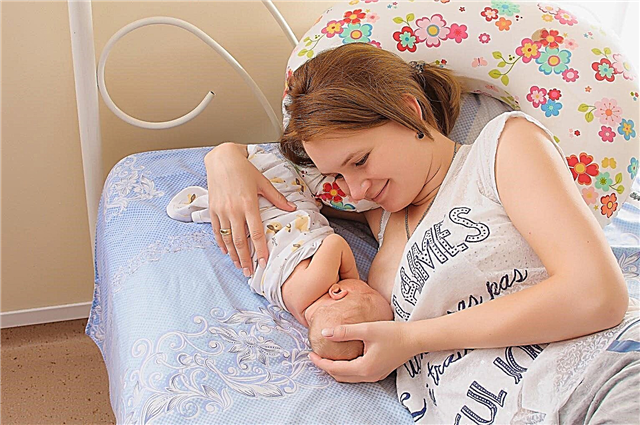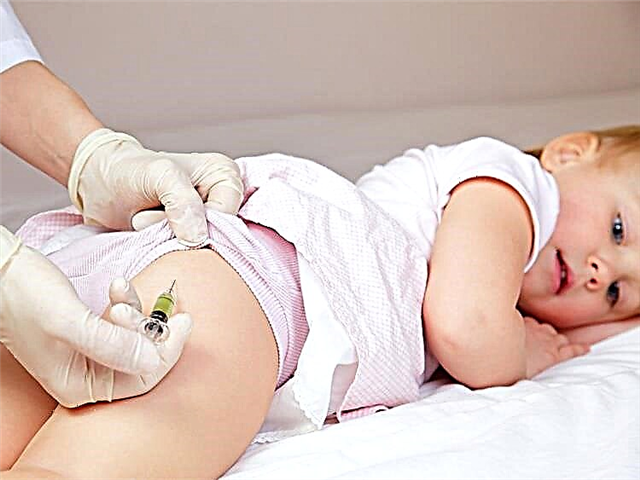There is no right or wrong way to latch on to a newborn while breastfeeding. Mom and child eventually find the most comfortable position for themselves. It will certainly not be superfluous to study several attachment techniques, since often changing life circumstances require a woman to be flexible. This is especially true of the growing up of an infant, who is growing and developing rapidly, showing more and more activity. At the initial stage of caring for the baby, the most comfortable are the "lying" positions for the GW. The article will discuss how to feed the baby while lying down, how to ensure the baby's comfort and safety during lactation.

The prone feeding option is one of the most comfortable
Convenience of lying down
This attachment option has a number of advantages:
- In this position, it will be convenient for mom to rest;
- The child also feels comfortable;
- This position ensures correct grip of the nipple;
- The baby is at a sufficient distance from the edge of the bed so as not to fall.
However, it is very important not to be distracted during feeding, otherwise there is a risk of harm to the baby. A child, for example, can roll out of bed and hit hard. Therefore, you need to secure the space around the baby in advance.
There are several variations of lying down feeding:
- Relaxed or reclining position;
- Lying on your side;
- On the shoulder, reclining;
- Jack;
- "Overhang";
- Lying from the upper chest;
- Riding my mother.
Each of these methods has its own nuances and characteristics. How to properly feed a newborn with breast milk lying in each case will be described below.
Lying Newborn Feeding Poses
Often, the very first position to apply is reclining (relaxed feeding). If a newly born baby is placed on her stomach or breast, she will reflexively reach for the milk source, trying to grab the nipple. Touching the skin stimulates the baby's food instinct, the gravitational force helps him to grip, while maintaining balance.
On a note. This position is very convenient for feeding not only newborns, but also suitable for older babies.
In addition, the relaxed position is ideal for when:
- The baby does not grasp the chest well;
- Mom has too big breasts;
- Mom has a strong rush of milk;
- The baby does not like touching the head during lactation.
Recommendation. It is most convenient to feed in a reclining position with support on pillows. This method of attachment gives the woman the opportunity to observe the baby during hepatitis B.
Another common relaxed feeding option is lying on your side. Recommended for women who have undergone surgery during childbirth. During lactation, the mother and newborn lie side by side with their bellies touching.

Relaxed feeding, reclining on your back
Before feeding a newborn baby lying on its side, you should find out for which cases this option is most suitable:
- Mom had a tear or a cesarean section;
- The woman does not get enough sleep, she is very tired, so it is difficult for her to sit during GW;
- The child has a shortened frenum of the tongue, as a result of which it is difficult for the baby to grasp and hold the nipple in the mouth in other positions.
Jack
Feeding a newborn baby with breast milk lying with a jack is not the most common position, but at the same time it is quite comfortable. With this method of attachment, the nursing woman and the baby lie on their sides. The baby's legs are located along the mother's head. This method of application is recommended for lactostasis, that is, in cases where milk stagnation is found in the upper parts of the glands. With the right position, the baby is saturated with milk, which comes from the upper walls of the breast. For greater safety and comfort, a pillow can be placed under the child's back.

Jack lactation
Overhang feeding
With this option of attachment, the child lies on his back, and the mother bends over him, standing on all fours, while the nipple should be in the baby's mouth. This position is recommended for mastitis and lactostasis, as well as for those cases when the newborn cannot capture the breast. When feeding in the overhang position, the mother can also sit, kneel next to the baby on an elevated position (for example, on a bed), or position herself in a reclining position, belly down and leaning on her elbows.
To relieve muscle tension and maximize comfort, you can use different sized pillows to lean on while breastfeeding.
On a note. The overhanging position is not popular because it is not very comfortable for a woman. There is no need to practice it all the time, except when you really need it.

Overhang feeding
Lying from the upper chest
With this pattern of attachment, the mother and baby lie on their sides facing each other. The baby sits on a pillow, mother gives him the upper breast. Feeding “lying from the upper breast” actively empties the lower part of the breast.
Riding mom
Otherwise, this method is called an upright pose or "koala pose". The baby sits on the mother's hip, his back is even, his head is raised. This option is ideal for older babies who can already sit on their own. Doctors also recommend a position for children who suffer from reflux or have a shortened frenum of the tongue.
Improper breastfeeding while lying down
When feeding, you should avoid situations when:
- Mom bends over the baby, leaning on her elbow (this position is uncomfortable and quickly tires a woman);
- The baby's head is turned away from the chest;
- The baby is far from the breast.
Also not recommended:
- To take away the breast from the baby - you need to wait until the baby is full and refuses to feed himself;
- Put up with pain during lactation;
- Allow the baby to grasp only the nipple (no areola);
- Apply the baby when the mother is sick or in an irritated, upset state;
- Ignore baby hiccups, coughing, restless behavior during lactation.
Factors Affecting Proper Feeding
There are several important rules and recommendations, the observance of which makes the GW process as comfortable and safe as possible.
Do I need to wake up for feeding
In the first month of its life, the baby sleeps more than 20 hours a day, spends the rest of the time getting food. It is not uncommon for an infant to fall asleep during lactation (whether breastfeeding or bottle fed) or sleep too long, thereby interfering with the feeding schedule. What should you do in this case?
Pediatricians recommend feeding your baby every 2-3 hours. When it comes to night lactation, experts advise a nursing woman to wake her baby up if he sleeps too long.

Pediatricians recommend waking the baby for feeding
On a note. A weak or underweight baby needs frequent and prolonged feeding. If such a baby does not wake up on his own for nightly lactation, postponing the nutrition schedule for several hours, then the child's body begins to experience a lack of fluid. To prevent dehydration and maintain the intensive feeding regimen, doctors recommend gently waking up the infant for hepatitis B.
How to make the process comfortable
The convenience of breastfeeding for a baby is determined by the following rules:
- The back, shoulders and neck of the newborn should be in line. The head should be slightly raised - this position will reduce the likelihood of regurgitation after lactation;
- The baby should be tightly pressed to him - only in this case he will feel relaxed and calm;
- The child's head must be supported with a free hand;
- In the process of feeding, clicking, smacking sounds should not come from the baby. These signs indicate an improper latch on the chest or indicate a problem with a shortened frenum of the tongue. In such cases, it is recommended to see a doctor or hepatitis B counselor;
- The baby's mouth should be against the nipple;
- It is not necessary to bring the breast to the child, but the child to the breast;
- You should not put pressure on the back of the head of the newborn, you just need to gently support it, without making any sharp or rough movements;
- It is necessary to ensure that the child's neck is flat, straight, the head is not thrown back or lowered. Otherwise, the swallowing process will not be carried out correctly;
- You should not press the baby's chin too tightly against the breast, otherwise the baby will not be able to open his mouth wide, which will interfere with the normal lactation process;
- If the baby's breathing is difficult, it is recommended to change the position by raising the baby's head, or tilt it at a different angle;
- If the mother has too large breasts, then you can put a rolled towel under it - it will serve as a support for the breast and reduce the pressure on the lower jaw of the newborn;
- During lactation, it is advisable to use special nursing pillows or regular pillows of different sizes to make the process more comfortable for both the mother and the baby. The adaptation helps to adjust the position of the participants in the process, if such a need arises;
- Before starting feeding, you should prepare everything you need, especially this rule applies to drinking water. The fact is that during lactation, the female body loses a lot of fluid, as a result of which the mother begins to feel thirst;
- When feeding, it is very important that mom and baby touch each other with exposed skin;
- A recliner or comfortable chair is recommended for seated positions. It is better to put your feet on a special stand or a small table, then you will not have to bend over to the baby during the GW process;
- Even small breasts should be supported as they become heavy when filled with milk. Keep your fingers away from the areola so that the baby does not accidentally grab them;
- The child should be supported by hand, as additional support, put a pillow, rolled up blanket or shawl under his head. Another option is to place the pillow on your lap and the baby on the pillow;
- It is recommended that you periodically change your feeding positions. This technique will serve as an effective prevention of lactostasis, infection and soreness of the nipples;
- The chest should also be alternated. This will stimulate milk production and prevent mastitis.
- It is important that mom is as relaxed as possible during GW.
It is advisable that the nursing mother knows what postures prevent regurgitation after hepatitis B. Here is one way to attach:
- The baby is on the left side;
- The baby can be secured with feeding rollers or pillows;
- Mom gives the baby a breast, lying on her side facing him.
The experience of breastfeeding in each case is individual, has its own nuances and characteristics. At the very beginning of the process, each woman needs a certain time to understand how to properly breastfeed a newborn while lying down, find a suitable position for herself and the baby, get used to it and establish a ritual. If you still have doubts, or if you have any questions, you can always consult a doctor or a HB consultant.



